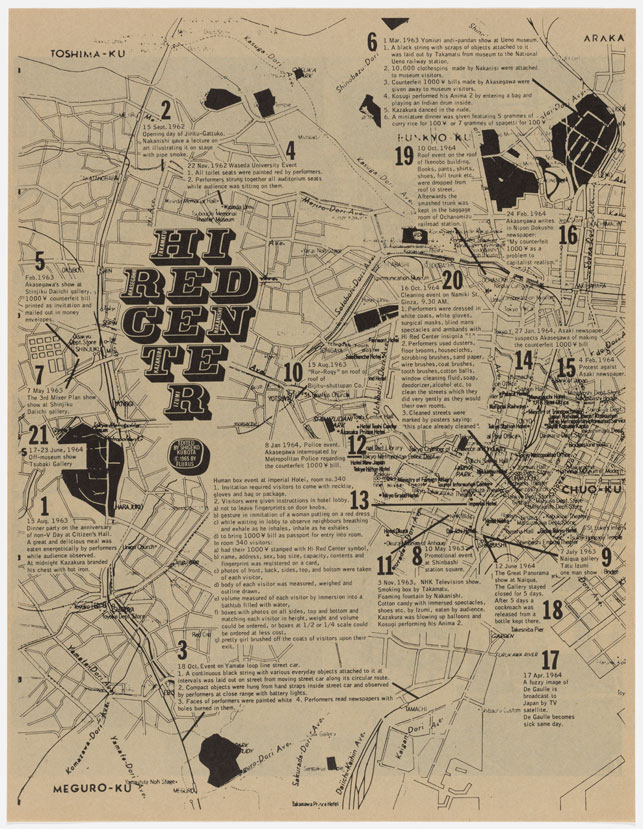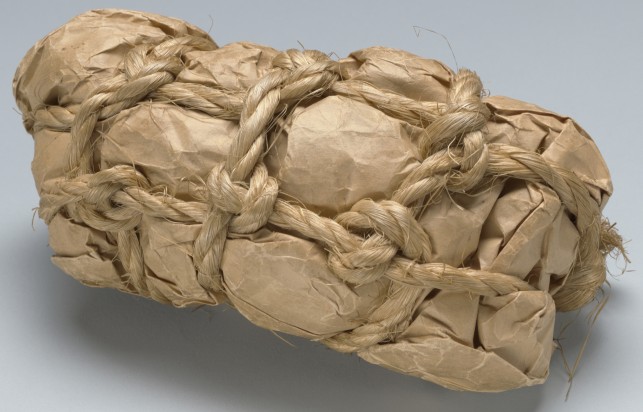Exhibiting Fluxus:
Mapping Hi Red Center
in Tokyo 1955–1970: A New Avant-Garde

Installation view of entrance to Tokyo 1955–1970: A New Avant-Garde at The Museum of Modern Art, November 19, 2012–February 25, 2013. Photo: Jonathan Muzikar
Fluxus currents flow throughout the exhibition Tokyo 1955-1970: A New Avant-Garde, not only in the graphic scores discussed in my last blog post, but also in a section devoted to the experimental art collective Hi Red Center. At the entrance to the gallery stands a monumental floor-to-ceiling map of the city of Tokyo, an enlarged version of a Hi Red Center poster, a 1965 Fluxus edition documenting the activities of the group, which was active in Tokyo from 1963 to 1964. In the galleries, two versions of the actual map are exhibited alongside other materials from the Gilbert and Lila Silverman Fluxus Collection Gift to represent the short-lived, yet radical art collective Hi Red Center.

Installation view of “Hi Red Center” display in Tokyo 1955–1970: A New Avant-Garde at The Museum of Modern Art, November 19, 2012–February 25, 2013. Photo: Jonathan Muzikar
Founded by artists Genpei Akasegawa (b. 1937), Natsuyuki Nakanishi (b. 1935), and Jiro Takamatsu (1936–1998), Hi Red Center took to the streets and executed a myriad of Happenings throughout Tokyo. The collective disavowed commercial tactics and sought to inject art into the urban infrastructure. Whether it be painting all the toilet seats red at Waseda University (Waseda University Event. 1963) or cleaning the streets of Tokyo in ironic defiance of the 1964 Olympic Games (Street Cleaning Event. 1964), the collective’s anti-institutional gestures made art out of the stuff of everyday life.

Hi Red Center. Hi Red Center poster (recto). Fluxus Edition, edited by Shigeko Kubota, designed and produced by George Maciunas, New York Edition announced 1965. Offset printing on paper, double-sided, 22 1/8 x 17″ (56.2 x 43.2 cm). The Museum of Modern Art, New York. The Gilbert and Lila Silverman Fluxus Collection Gift. © 2013 The Estate of Takamatsu Jirō, courtesy Yumiko Chiba Associates, Tokyo. Photo: Peter Butler
Unlike a conventional map, the Hi Red Center poster is not a standardized tool for geographic orientation. Rather, the collective conceptualized the map as a means of crystallizing their ephemeral actions and public interventions—literally etching them onto the city grid. By superimposing documentation of their subversive actions onto a map of Tokyo, Hi Red Center reimagined the city’s urban landscape. In lieu of a traditional coordinate plane, lines connect geographic points to corresponding textual descriptions of events orchestrated by the collective. On the backside of the map are corresponding documentary photographs that provide visual evidence of interventions such as Dropping Event (October 10, 1964), during which Hi Red Center associates flung the contents of a suitcase, followed by the suitcase itself, off the rooftop of the Ikenobo Flower School’s headquarters. According to the text on the map, dropped items included “books, pants, shirts, shoes, full trunk, etc.”

Hi Red Center. Hi Red Center poster (verso). Fluxus Edition, edited by Shigeko Kubota, designed and produced by George Maciunas, New York Edition announced 1965. Offset printing on paper, double-sided, 22 1/8 x 17″ (56.2 x 43.2 cm). The Museum of Modern Art, New York. The Gilbert and Lila Silverman Fluxus Collection Gift. © 2013 The Estate of Takamatsu Jirō, courtesy Yumiko Chiba Associates, Tokyo. Photo: Peter Butler
Another documented Happening is Shelter Plan, an invitation-only event staged at Tokyo’s Imperial Hotel. Guests including Fluxus artists Yoko Ono and Nam June Paik were instructed to arrive at a particular suite where they underwent extensive physical examinations to provide the collective with the necessary data to design personalized nuclear fall-out shelters with a tailored fit. Video and paper documentation of this event is included in the exhibition along with five Mystery Cans, tin cans marked with the collective’s red “!” insignia and filled with unknown contents—presumably only to be revealed in the instance of nuclear disaster.

Hi Red Center. Mystery Cans (also known as Shelter Plan, HRC Hi Red Cans). 1964. Five metal cans with paper labels (contents unknown), dimensions (from left): 3 1/8 x 2 9/16 x 2 9/16″ (8 x 6.5 x 6.5 cm); 2 3/16 x 2 x 2″ (5.6 x 5.1 x 5.1 cm); 2 3/16 x 1 15/16 x 1 15/16″ (5.6 x 5 x 5 cm); 2 3/16 x 1 15/16 x 1 15/16″ (5.6 x 5 x 5 cm); 3 x 2 1/2 x 2 1/2″ (7.6 x 6.3 x 6.3 cm). The Museum of Modern Art, New York. The Gilbert and Lila Silverman Fluxus Collection Gift. © 2013 Multiple artists. Photo: Peter Butler
The contents of these cans aren’t the only mystery surrounding Hi Red Center. The exact number and names of its numerous collaborators are also largely unknown. The collective enlisted a rotating cast of participants to execute a variety of actions at different times and places throughout Tokyo. The Hi Red Center poster speaks to the networked nature of the collective and of Fluxus itself. The collective, initially a trio comprising Genpei Akasegawa, Jiro Takamatsu, and Natsuyuki Nakanishi, expanded over the course of its short lifespan to include a number of anonymous “associates” in Tokyo, as well as collaborators in New York City. Accordingly, these guerrilla-style interventions should not be seen as the authored work of individuals, but rather as the activities of an amorphous collective with a shared calling card: a bright red exclamation mark. A year prior to the map’s publishing, its editor and translator Shigeko Kubota traveled from Tokyo to New York City to join George Maciunas’s Fluxus collective—a journey documented in her letter to Maciunas also on display in Tokyo 1955–1970. Consulting her collection of Hi Red Center printed matter and corresponding with the group’s core members, Kubota created the annotated map meant to introduce the collective’s activities to a Western audience.

Hi Red Center. Bundle of Events. Prototype, 1965 (editioned version on view). Crumpled paper bound with rope, overall: 2 3/4 x 5 7/8 x 3 1/8″ (7 x 15 x 8 cm). The Museum of Modern Art, New York. The Gilbert and Lila Silverman Fluxus Collection Gift. © 2013 Multiple artists. Photo: Peter Butler
Like many Fluxus editions, the map was published and distributed in a variety of formats, both as a stand-alone art object and as a component of the anthologies and Fluxkits. Honoring Genpei Akasegawa’s trademark aesthetic of bundled objects wrapped in rope or fabricated 1,000-Yen-Notes, the Hi Red Center poster was also sold crumpled, tied with rope, and dubbed Bundle of Events. This version, even further removed from the standardized function of a map, is also on display. Bundle of Events is a fitting name for the aggregation of events that together transformed Tokyo’s urban landscape into fertile grounds for social and artistic experimentation. This map serves as an ideal entry point to Tokyo 1955–1970, considering that the exhibition’s timeline highlights a moment in Tokyo when art was infiltrating public space and converting the streets into laboratories for experiments in the everyday.
